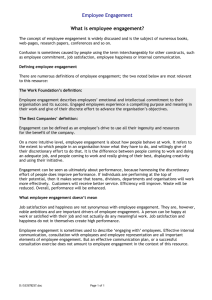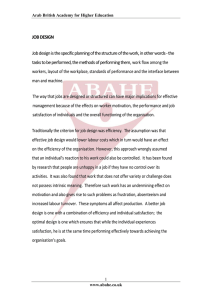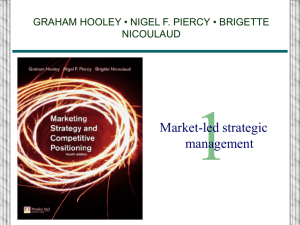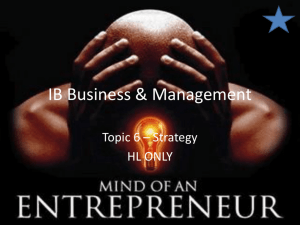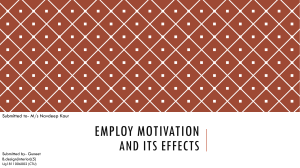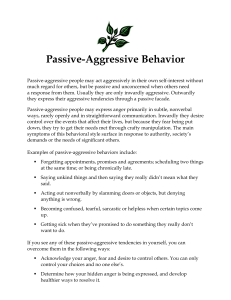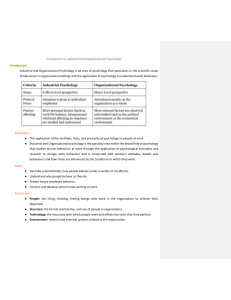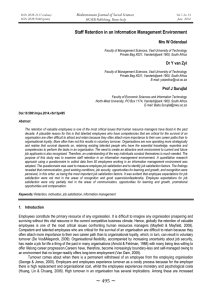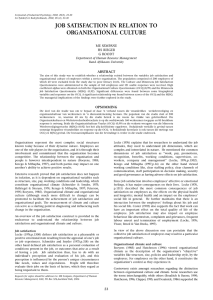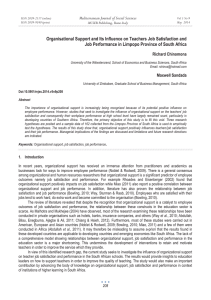Execution is strategy.
advertisement
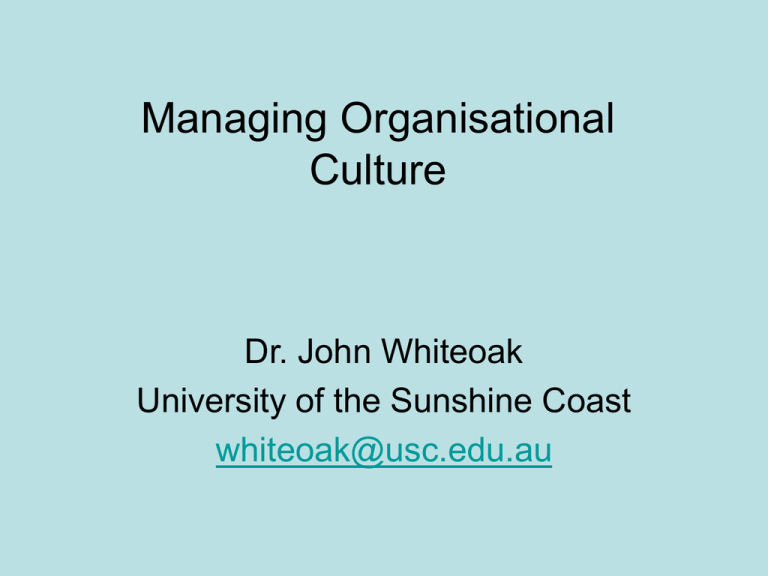
Managing Organisational Culture Dr. John Whiteoak University of the Sunshine Coast whiteoak@usc.edu.au Culture = Soft BUT Soft = Hard PASSIVE-AGGRESSIVE Organisational Cultures SOURCE: Neilson et al. Harvard Business Review. 2005. Passive-Aggressive Cultures • 3 out of 10 people in the US report having a passiveaggressive cultures • Feigning sweetness between subordinates and supervisors • Robotic submission to leadership • Put in only enough effort to appear compliant • Lack of dissenting opinion – making waves is the ultimate sin. • Blaming outside sources for poor performance. • A vicious – highly effective grapevine • Bosses use intimidation • Very few consequences for bad behaviour • Environment is secretive –ripe for scandals, sexual harassment, and financial misdeeds. What is our strategy? Or more importantly Why is our strategy? Why Do Organisations Vision? Brings people together around a common dream Co-ordinates the work of different people Helps everyone make decisions Builds a foundation for business planning Challenges the comfortable or inadequate present state Makes incongruent behaviour more noticeable A POWERFUL VISION STATEMENT Presents where we want to go. Easy to read and understand. Captures the desired spirit of the organisation. Dynamically incomplete so people can fill in the pieces. Provides a motivating force, even in hard times. Is perceived as achievable. Is challenging and compelling, stretching beyond what is comfortable. A mission statement answers the basic question…. “So What Are You On About?” ELEPHANT HUNTING • The Issues, Challenges, KRAs (The Big Stuff) • Environmental Scans – Conduct Research • Doing a SWOT is not strategy • No more than 6 • About 3 strategies per issue • Measures and accountability developed for each strategy The “Big Three” “Justa”s “The strategy is right. It’s just a communications problem.” “The plan is dead on—it’s just an implementation problem.” “Look, we’ve got the strategy right—we just need to fix the people bit.” Successfully executing strategy depends to a great extent on how well the organisation is aligned with the strategy (Darryl Krook, MD, CPEM Consulting) “Execution is strategy.” —Fred Malek fffffii Vision statements count for little if more than half the employees do not share the company values SEEK Employee Satisfaction & Motivation Survey 2004 Stanford Research on Values More effective companies have three qualities in common around their values: Consensus Clarity Intensity Typical Organisational Values • • • • • • • Career Resilience Employment at “Will” Select people for skills not attitudes and fit Buy rather than make talent Lean staffing Periodic downsizing Money is the primary motivator – Individual incentives – Pay-for-performance • Share holder value 1st and last Assumptions about people • Effort averse • Management and employee interests are not aligned • People are opportunistic – (self-interest seeking, will take advantage) • Mangers need to design incentive systems to overcome these differences • High powered incentives (money) are better than low-powered • People work for money and will comply with management to get it Management Hot Air “All organisations routinely say that ‘people are our greatest asset’. Yet few practice what they preach, let alone truly believe it … organisations have to market membership as much as they market products and services – and perhaps more”. (Peter Drucker, 1992) Culture is about Getting Good People? – The war for talent (The Mckinsey Quarterly, 1998) – Get great results with ordinary people Value, O’Reilly & Pfeffer,1996) (Hidden the most important aspect of business “In short, hiring is and yet remains woefully misunderstood.” Source: Wall Street Journal, 10.29.08, review of Who: The A Method for Hiring, Geoff Smart and Randy Street #1 cause of Dis-satisfaction? Employee retention & satisfaction: Overwhelmingly, based on the firstline manager! Source: Marcus Buckingham & Curt Coffman, First, Break All the Rules: What the World’s Greatest Managers Do Differently “You have to treat your employees like customers.” —Herb Kelleher, complete answer, upon being asked his “secrets to success” Source: Joe Nocera, NYT, “Parting Words of an Airline Pioneer,” on the occasion of Herb Kelleher’s retirement after 37 years at Southwest Airlines (SWA’s pilots union took out a full-page ad in USA Today thanking HK for all he had done; across the way in Dallas American Airlines’ pilots were picketing the Annual Meeting) 139,380 former patients from 225 hospitals: Press Ganey Assoc: none of THE top 15 factors determining Patient Satisfaction referred to patient’s health outcome P.S. directly related to Staff Interaction P.S. directly correlated with Employee Satisfaction Source: Putting Patients First, Susan Frampton, Laura Gilpin, Patrick Charmel “Natural selection is death. ... Without huge amounts of death, organisms do not change over time. ... Death is the mother of structure. ... It took four billion years of death ... to invent the human mind ...” — The Cobra Event The greatest danger for most of us is not that our aim is too high and we miss it, but that it is too low and we reach it. Michelangelo Mediocrity is a Disease No obvious ‘Crisis’ Great resources Management “happy talk” General low standards Denial of bad news Complacency Low confrontation culture Focus on narrow functional goals Internal measures have inappropriate performance indices Inadequate external reporting feedback Management Support • True Believer: highly committed to the values and persistent • Believer: supports values but other priorities dominate • Skeptic: doubts about values being effective • Detractor: open, visible troublemaker, undermines values Source: Adapted from McDonald, G. (1989). Manager attitudes to training. Asia Pacific HRM, 27(4). Manager’s 10 point checklist self assessment In the past month I have…. 1. ….Used stories to reinforce the organisation’s values 2. ….Verbally acknowledged individual’s efforts and achievements 3. ….Written a note to someone to acknowledge special effort and achievements 4. ….Had a discussion with one of my direct reports in relation to their role, personal development and career aspirations 5. ….Provided constructive feedback to one of my direct reports on how they could improve the way they are doing things 6. ….Invested some one-on-one time with one of my direct reports to ‘chew the fat’ 7. ….Invested some face time with employees at lower levels in the organisation 8. ….Invested some time in ‘tapping the pulse’ listening to people’s issues and concerns 9. ….Had a conversation concerning poor performance and how to deal with it effectively 10. ….Prompted people to collaborate and share information and experience with people in other parts of the organisation


